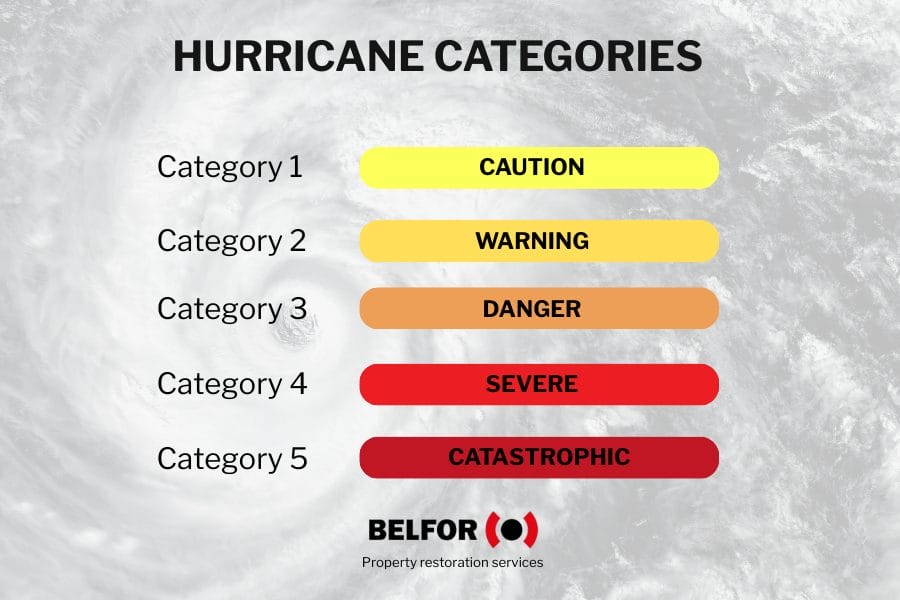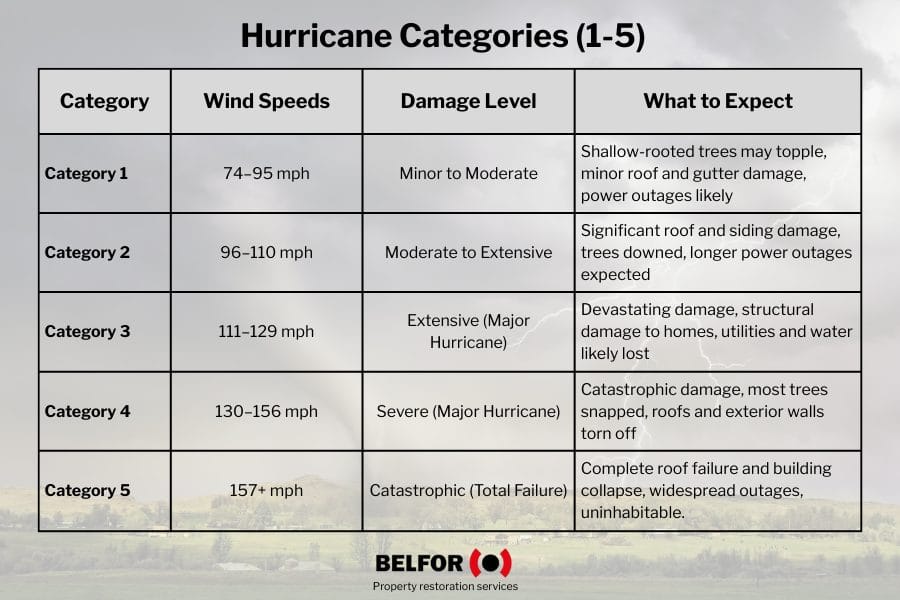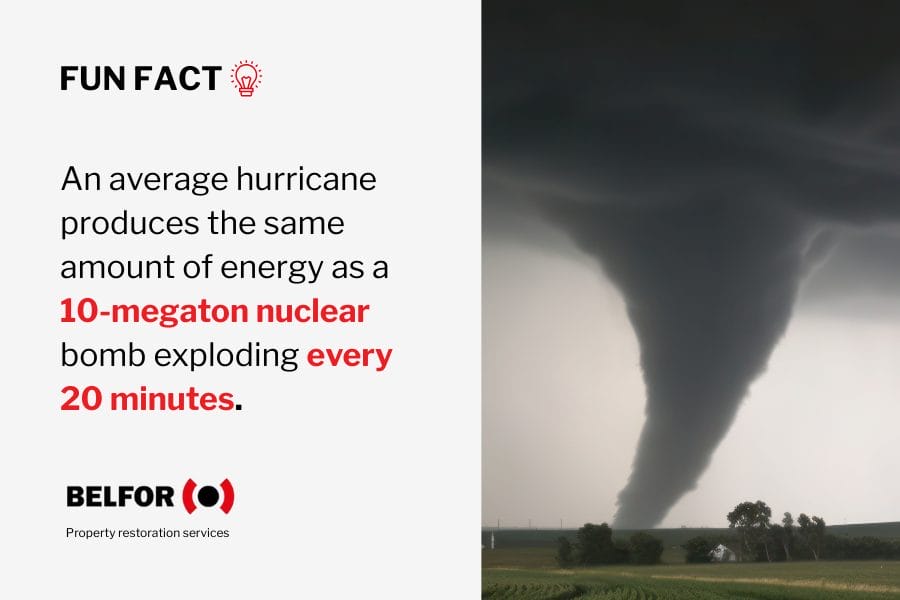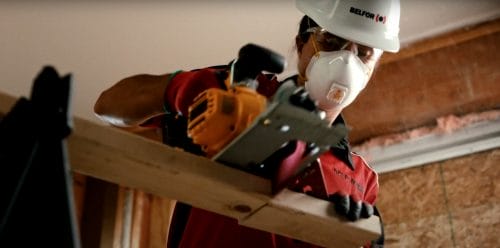Hurricane Categories 1 to 5 [Wind Speeds, Damage Levels + Tips]

Hurricane Categories: Key Points
- Hurricanes are ranked from Category 1 to 5 based on wind speed and damage potential
- Storm surge and rainfall can cause catastrophic damage regardless of category
- The Saffir-Simpson Scale focuses on wind, but hurricanes also bring flooding, tornadoes, and prolonged power outages
- Hurricane categories are based on measured wind speeds using advanced tools like anemometers, Doppler radar, and satellite data
- From reinforcing windows to planning evacuations, knowing the category is only part of staying safe, as timing and early action are critical
Each year, an average of 14 named storms hit the Atlantic, and 7 of them become hurricanes.
Of those, 3 typically reach major hurricane status that is Category 3 or higher.
Understanding hurricane categories isn’t just about tracking the weather, it’s about preparing your home, protecting your loved ones, and responding safely when storm damage hits.
This guide will help you understand:
- What each hurricane category (1 through 5) really means
- How wind speeds and damage levels increase across the scale
- Why Category 5 isn’t necessarily the “limit” and what could come next
- How to prepare for each category with safety tips
Hurricane Categories 1 to 5: Wind Speeds and Damage Levels
Hurricanes are classified into five categories based on their sustained wind speeds using the Saffir-Simpson Hurricane Wind Scale.
Here’s a breakdown of what to expect from each category:
Category 1 Hurricane
Small but still dangerous, don’t underestimate it.
- Wind speeds: 74–95 mph
- Damage level: Minimal to moderate
Winds in this range can:
- Snap tree branches
- Damage roof shingles
- Down power lines and cause outages
- Tear gutters and siding from homes
Hurricane Danny (1997) made landfall as a Category 1 and still caused over $100 million in damages due to flooding and wind.
Pro tip: Don’t underestimate a Category 1 hurricane. Secure outdoor furniture, check your emergency kit, and monitor local advisories closely.
Category 2 Hurricane
This is when things start to get serious.
- Wind speeds: 96–110 mph
- Damage level: Moderate to extensive
With stronger winds, a Category 2 hurricane can:
- Cause major roof and siding damage
- Uproot shallow-rooted trees
- Severely damage mobile homes
- Result in prolonged power outages (several days to weeks)
Hurricane Frances (2004), a Category 2, left over 6 million without power in Florida.
Pro tip: Evacuate mobile homes in vulnerable areas. Check insurance documents and take “before” photos of your property for claim support.
Category 3 Hurricane
Now it’s a major hurricane and it shows.
- Wind speeds: 111–129 mph
- Damage level: Devastating
Expect:
- Devastating structural damage to well-built homes
- Entire trees snapped or uprooted
- Power and water outages lasting weeks
- Limited access to affected areas due to debris
Hurricane Katrina (2005) made its initial landfall as a Category 3 and caused catastrophic damage, especially due to flooding.
Pro tip: Authorities may issue mandatory evacuations at this level. Prepare to leave early to avoid traffic and road closures.
Category 4 Hurricane
At this level, the damage turns devastating.
- Wind speeds: 130–156 mph
- Damage level: Severe to catastrophic
The hurricane poses a serious threat to life and property because:
- Roofs may be completely torn off
- Most trees will be uprooted or snapped
- Residential areas may become uninhabitable for weeks or months
- Widespread flooding is likely with storm surge
Hurricane Harvey (2017) made landfall in Texas as a Category 4, dropping over 60 inches of rain and flooding thousands of homes.
Pro tip: Don’t wait. Have your evacuation route ready, and make plans for pets, medications, and important documents.
Category 5 Hurricane
Nothing about this category is survivable without preparation.
- Wind speeds: 157+ mph
- Damage level: Catastrophic
Category 5 hurricanes are rare, but their impact is unmatched:
- Total roof failure and wall collapse are possible
- Entire neighborhoods can be leveled
- Infrastructure like water and electricity may be offline for weeks or longer
- Recovery may take months or even years
Hurricane Dorian (2019) devastated the Bahamas as a Category 5 with sustained winds of 185 mph.
Pro tip: These storms are life-threatening. If you’re told to evacuate, do not delay as Category 5 storms leave little room for error.

How Hurricane Categories Are Determined
When a hurricane forms, meteorologists use a combination of tools, data models, and real-time measurements to classify its strength.
Here’s how hurricanes are measured and why category alone doesn’t always reflect the full threat:
Tools and Technology Used to Measure Hurricanes
To classify a hurricane, meteorologists rely on advanced instruments that track the storm’s size, speed, and intensity:
- Hurricane Hunter aircraft: These planes fly directly into hurricanes, collecting wind speed, pressure, temperature, and humidity data.
- Doppler radar: Tracks rainfall rates, storm rotation, and movement.
- Satellites: Monitor storm cloud patterns and overall development from space.
- Buoys and ocean sensors: Measure wave heights, sea surface temps, and barometric pressure in real time.
Did You Know? The National Hurricane Center (NHC) uses a combination of these tools to issue timely alerts and category updates.
The Role of Wind Speed, Pressure, and Storm Surge
The Saffir-Simpson scale classifies hurricanes based on sustained wind speed:
- Category 1: 74–95 mph
- Category 5: 157+ mph
However, wind isn’t the only factor considered when evaluating a hurricane’s threat. Meteorologists also analyze:
- Central pressure: Lower pressure often indicates a stronger storm, even before wind speed increases.
- Storm surge potential: High winds push seawater onto land, leading to flooding in coastal areas.
Example: Hurricane Sandy (2012) was a Category 1 storm but caused over $70 billion in damage, mainly due to storm surge and flooding, not wind.
Why Intensity Isn’t the Only Risk
It’s a common misconception that a storm with a higher category always implies greater danger.
While wind damage is a major concern, water is often the deadliest part of a hurricane:
- Flash flooding from heavy rain can happen far inland, even days after landfall.
- Storm surge can destroy entire coastal communities regardless of category.
- Tornadoes may form in a hurricane’s outer bands, adding further risk.
Pro tip: Don’t focus solely on the number. Always monitor water damage, flood risk, rainfall forecasts, and evacuation orders, even for lower-category storms.

Hurricane Categories Scale and Could It Change?
The hurricane scale was developed in the early 1970s to help communicate the severity of a hurricane’s wind threat and its potential for property damage.
Why the Scale Stops at Category 5
Category 5 hurricanes include any storm with sustained winds of 157 mph or higher.
The original designers of the scale believed wind speeds above that threshold would cause “catastrophic” damage to virtually all structures, making higher categories unnecessary.
In other words, Category 5 was meant to be the ceiling, a storm strong enough to flatten homes, destroy infrastructure, and make areas uninhabitable for weeks or even months.
But recent storms have tested that limit.
Debate or Research Around a Potential Category 6
With climate change contributing to more intense hurricanes, researchers and meteorologists have started asking: Should we add a Category 6?
Some storms in recent years have reached wind speeds well beyond 180 mph.
For example:
- Hurricane Patricia (2015): 215 mph winds (Eastern Pacific)
- Typhoon Haiyan (2013): 195 mph winds (Philippines)
These storms would far exceed the minimum threshold of Category 5, prompting debate about whether a sixth category would help the public better grasp the danger.
So far, no official changes have been made to the Saffir-Simpson scale, but the conversation continues as hurricane intensity trends upward.
Safety Tips Based on Hurricane Categories
Understanding the steps to take before, during, and after a storm can significantly impact your safety and recovery.
Category 1 or 2 Hurricane: Stay Alert and Prepare
While these are considered “weaker” storms, they can still cause significant power outages, fallen trees, and minor structural damage.
Safety tips:
- Bring inside outdoor furniture, trash bins, and anything that can become windborne.
- Charge your phone, power banks, and backup batteries in case of outages.
- Check windows and doors for any loose seals or frames and secure them.
- Review your emergency contact list and make sure loved ones are informed.
Pro tip: Even Category 1 storms can cause dangerous flooding. Monitor local flood alerts and avoid driving through water-covered roads.
Category 3 Hurricane and Above: Prepare To Evacuate
Category 3, 4, and 5 storms are classified as major hurricanes. These storms pose serious risks to life and property and often result in mandatory evacuations for coastal and low-lying areas.
Evacuation tips:
- Know your evacuation zones ahead of time and follow local orders promptly.
- Fill up your gas tank in advance and map alternate routes out of the area.
- Pack a go-bag with essentials such as medication, ID, cash, water, non-perishables, and chargers.
- If you have pets, make sure your evacuation plan includes them.
Pro tip: Don’t wait for the wind to pick up. Leave as soon as evacuation is advised, as delaying can leave you stranded or trapped.
Hurricane Categories: Key Takeaways
- The category is based on wind speed, not flooding or rainfall, so lower-category storms can still be extremely destructive.
- Flooding and storm surge often cause more deaths than wind damage.
- Currently, Category 5 is the highest, but some scientists believe we may need a Category 6 to reflect future superstorms.
- Preparation should begin before hurricane season starts. Evacuation planning, securing your home, and knowing your risk level can save lives.
Trust BELFOR for Hurricane Damage Response and Recovery
At BELFOR, we understand the urgency, complexity, and emotional weight that follow in the wake of a hurricane.
Whether you’re dealing with wind damage, flooding, or structural issues, our goal is to restore your property and your peace of mind, as quickly as possible
With more than 70 years of experience in disaster recovery, we’re ready to respond 24/7, delivering expert support when you need it most.
When you choose BELFOR, you get:
- Rapid emergency response: Our teams mobilize quickly to stabilize damage and begin recovery within hours.
- Comprehensive restoration services: From water extraction and structural drying to mold remediation and repairs, we handle it all.
- Advanced technology and equipment: We use cutting-edge tools to detect hidden damage, restore air quality, and bring properties back to life.
- Insurance support: We document every step and work directly with your provider to streamline the claims process.
- Trusted expertise: Thousands of homeowners, businesses, and governments rely on BELFOR after major disasters.
.jpg)


